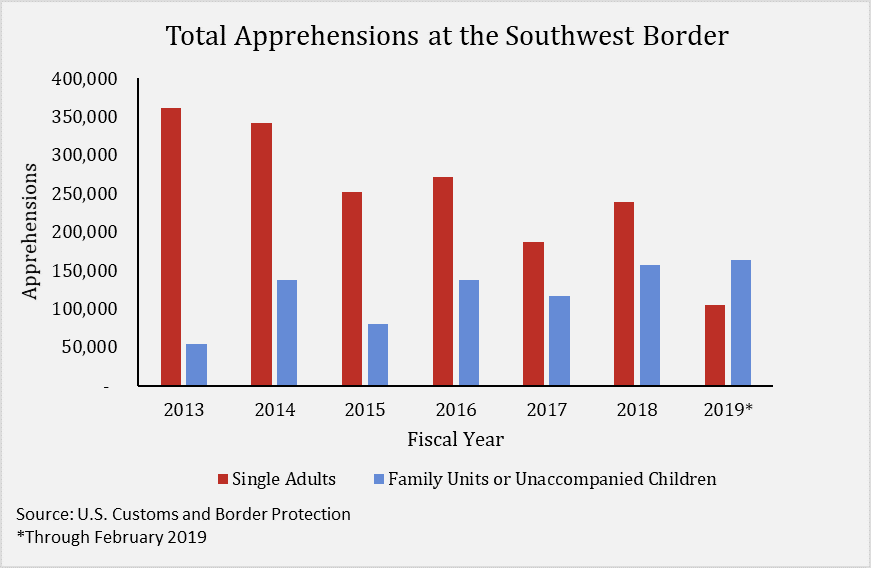Insight
April 3, 2019
Implications of Closing the U.S.-Mexico Border
Executive Summary
- The increased number of people crossing the U.S.-Mexico border and seeking asylum – though not outside of historical norms – has strained U.S. immigration officers and spurred President Trump to announce that he will “close” the border.
- While the details of the president’s plan are unclear, closing the border will cause massive disruptions: Each day on average, 529,000 people legally cross the border, as do $1.7 billion in goods, 17,000 trucks, and 3,000 trains.
- A far better approach to address the uptick in asylum seekers would be to allocate more resources to immigration officers and judges tasked with processing both legitimate and illegitimate claims of asylum.
Introduction
President Trump recently announced that he will close the U.S.-Mexico border, or large sections of it, due to the influx of Central American asylum seekers traveling to the United States. While the details of the president’s plan are not yet clear, shutting down the border will undoubtedly have significant implications for both prospective immigrants and U.S. businesses engaged in cross-border commerce.
The Situation at the Border
According to Department of Homeland Security Secretary Kirstjen Nielsen, the United States is on track to apprehend the largest number of unauthorized border crossers in a decade – more than 100,000 in March of this year. This number would be the highest monthly total since May of 2006, when 105,000 unauthorized individuals were apprehended by Border Patrol agents. That being said, flows are generally in line with recent norms: Roughly 400,000 individuals were apprehended at the southwest border in fiscal year 2018, a 30 percent increase from the year prior but 3 percent below the number of individuals apprehended in 2016. Furthermore, the average number of apprehensions has drastically fallen since the early 2000s. From 2000 to 2005, apprehensions along the southern border averaged 1.2 million per year, compared to roughly 390,000 per year from 2013 to 2018.
What has been changing, however, are the characteristics of individuals apprehended at the border. Thus far in fiscal year 2019, over 60 percent of individuals were either unaccompanied children or apprehended with family members, compared to just 13 percent in 2013. This reflects the significant increase in asylum seekers from Central America fleeing violence or persecution in their home countries. Indeed, the number of credible fear interviews (available to individuals caught at the border who claim fear of persecution or torture) has skyrocketed from fewer than 5,100 in 2008 to 92,000 in 2016. Of these, 75 percent met the credible fear standard. The following chart displays the shift in characteristics of unauthorized immigrants apprehended at the border since 2013.
Impact of a Border Shutdown
To understand what closing the U.S.-Mexico border might entail, it is valuable to examine similar instances of border closures in the past. U.S. presidents have “shut down” the southern border three previous times: in 1963 after the assassination of President John F. Kennedy, in 1969 to stop the flow of marijuana from Mexico to the United States, and in 1985 after the abduction of a U.S. Drug Enforcement Administration agent by a Mexican cartel.
In the first instance, all border traffic was completely halted during the nationwide manhunt for President Kennedy’s killer. President Trump could take a similar tack and completely close the southern border to all individuals seeking entry. While the intent may be to prevent unauthorized crossings, the impact on legal immigration would be severe: Nearly 529,000 individuals legally enter the United States via the U.S.-Mexico border each day. Like in the past, closing the border would stop the flow of legal immigration, cutting off U.S. employers from the workers they need and significantly harming the U.S. tourism industry. Moreover, the United States has the obligation under domestic and international law to hear the cases of individuals fleeing violence or persecution. Closing the border would not alter this fact. Instead, it would likely exacerbate the backlog of nearly 800,000 pending immigration cases waiting to be heard.
The second two closures, in 1969 and 1985, did not completely cut off crossings, but instead effectively halted traffic by dramatically increasing searches of vehicles and pedestrians crossing the border. In 1969, every vehicle entering the United States was required to be searched, which led to extreme crossing delays. Migrant farm workers and other temporary laborers were unable to report to work, and U.S. businesses relying on cross-border commerce were severely impacted as a result. Mexico was also preparing to boycott U.S. goods, which would have dramatically reduced exports and intensified the economic harm. Similar economic impacts were felt during the 1985 border closure when increased inspections produced delays of seven hours or more, bringing all crossings – both legitimate and otherwise – nearly to a halt.
The same problems would undoubtedly result today. If President Trump chooses to ramp up inspections as past administrations have done, we can expect border delays at least as significant as under previous closures. Secretary Nielsen conceded last week that changes in border staffing to address the migrant crisis should be expected to delay the processing of both goods and people across the border. By extension, if President Trump were to increase inspections dramatically like in the past, he would effectively bring both to a standstill.
Regardless of the president’s method, closing the border will hurt the American businesses and consumers that rely on trade. On average, $1.7 billion of goods are traded between the United States and Mexico each day. Mexico is the United States’ third largest trading partner and a huge part of our economy, supporting 4.5 million U.S. jobs in 2018. Whether immigration is cut off or searches are ramped up, commerce would effectively grind to a halt – ceasing or significantly slowing 17,000 trucks and 3,000 trains that cross the border daily, on average.
President Trump alluded to the trade impacts of a border closure, claiming “with a [trade] deficit like we have with Mexico…closing the border will be a profit-making operation.” The trade deficit, however, is not an indicator of economic harm, nor is it something that can be corrected by cutting off trade with Mexico. Instead, if the president halts imports from Mexico, the supply of many goods that Americans enjoy would be cut off completely. This policy would, in the short term, lead to disruption in U.S. business activity and cross-border supply chains as well as product shortages and drastic price increases, and in the long term either import substitution or higher-cost U.S. production. Furthermore, Mexico would likely boycott the United States as it did in the past, jeopardizing $265 billion (16 percent) of U.S. exports.
Conclusion
Escalating violence in Central America has led to a growing number of families fleeing to the United States, more than current government resources can manage. It is clear, however, that the president’s plan to close the border is misguided. Not only will it cause significant economic harm to the United States, but it will also not solve the underlying problem. Instead of increasing tensions with Mexico, jeopardizing the U.S. economy, and simply delaying our obligation to hear these asylum claims, the president should consider allocating more resources to immigration officers and judges tasked with processing both legitimate and illegitimate claims of asylum.











